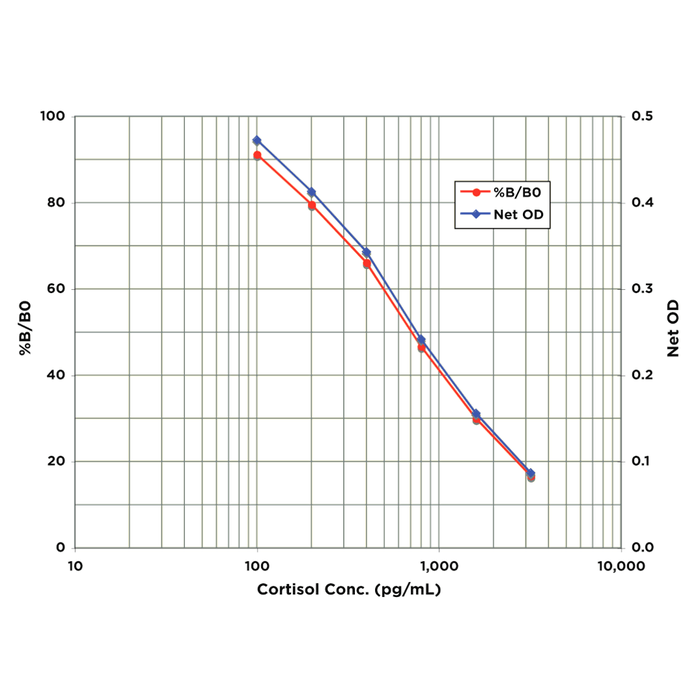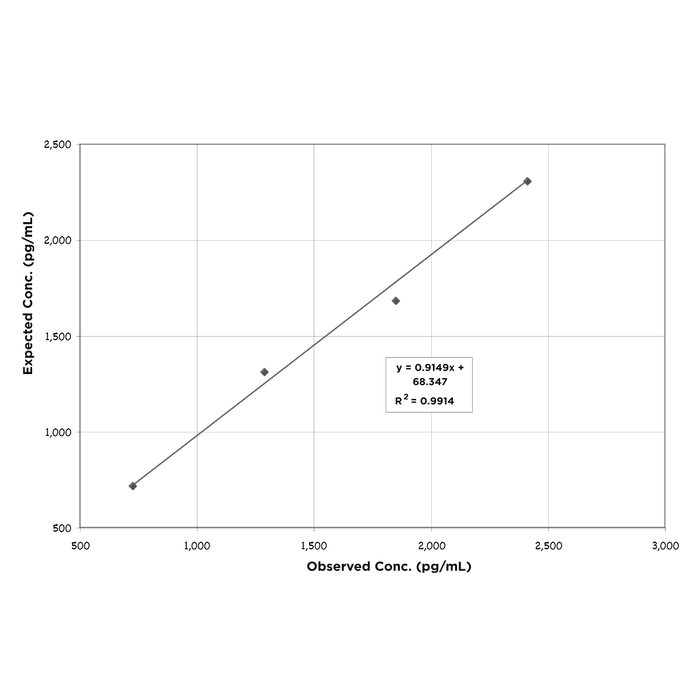SKT-201-96
StressXpress® Cortisol EIA Kit
Stressmarq Biosciences
Image

Image

DETAILS
- Item: Clear Microtitre 96 well Plate | Cortisol Standard | StressXpress® Cortisol Antibody | StressXpress® Cortisol Conjugate | Assay Buffer | Dissociation Reagent | Wash Buffer Concentrate | TMB Substrate | Stop Solution | Plate Sealer
- Target: Cortisol
- Utility: EIA kit used to quantitatively measure cortisol present in samples.
- Category: Assay Kits
- Platform: Microplate
- Precision: Intra Assay Precision: Three human samples were diluted with Assay Buffer and run in replicates of 20 in an assay. The mean and precision of the calculated Cortisol concentrations were: Sample 1- 1174.3 pg/mL, 6% CV Sample 2- 475.9 pg/mL, 5.6% CV Sample 3- 177.4 pg/mL, 14.7% CV Inter Assay Precision: Three human samples were diluted with Assay Buffer and run in duplicates in ten assays run over multiple days by four operators. The mean and precision of the calculated Cortisol concentrations were: Sample 1- 1188.1 pg/mL, 7.2% CV Sample 2- 508.7 pg/mL, 6.3% CV Sample 3- 199.7 pg/mL, 10.9% CV
- Assay Type: Competitive EIA (Enzyme Immunoassay)
- References: 1. E. Friess, et al., Eur J Clin Invest, 2000, 30, Suppl 3:46-50. 2. Freeman, Scott, 2002. Biological Science. Prentice Hall; 2nd Pkg edition (December 30, 2004). 3. C. Longscope., J. Endocrinology, 1996, , Suppl S125-S127. 4. J. Herbert, Lancet, 1995 345, 1193-1194. 5. A. Michael, et al., Biol. Psychiatry, 2000, 48, 989-95. 6. C.R. Dequet and D.J. Wallace, Current Opin. Ivest. Drugs, 2001, 8, 1045-53. 7. W.M. Jeffries, Med. Hypotheses, 1998, 51, 114-4.
- Assay Range: 100 - 3200 pg/ml
- Description: Quantitative colorimetric detection of cortisol
- Sensitivity: 17.3 pg/ml
- Component No: SKC-201A | SKC-201B | SKC-201C | SKC-201D | SKC-201E | SKC-201F | SKC-201G | SKC-201H | SKC-201I | SKC-201J
- Field of Use: Not for use in humans. Not for use in diagnostics or therapeutics. For in vitro research use only.
- Net Weight G: 300
- Product Type: EIA Kits
- Sample Types: Dried Fecal Samples | Saliva | Urine | Serum | EDTA Plasma | Heparin Plasma | Tissue Culture Media
- Stock Product: Y
- Assay Overview: The Cortisol EIA kit is designed to quantitatively measure cortisol present in dried fecal extracts, saliva, urine, serum, plasma and tissue culture media samples. This kit measures total cortisol in extracted samples and in serum and plasma and free cortisol in saliva and urine. A cortisol standard is provided to generate a standard curve for the assay and all samples should be read off the standard curve. Standards or diluted samples are pipetted into a clear microtiter plate coated with an antibody to capture mouse antibodies. A cortisol-peroxidase conjugate is added to the standards and samples in the wells. The binding reaction is initiated by the addition of a monoclonal antibody to cortisol to each well. After an 1 hour incubation the plate is washed and substrate is added. The substrate reacts with the bound cortisol-peroxidase conjugate. After a short incubation, the reaction is stopped and the intensity of the generated color is detected in a microtiter plate reader capable of measuring 450 nm wavelength. The concentration of the cortisol in the sample is calculated, after making suitable correction for the dilution of the sample, using software available with most plate readers.
- Quantity Size: 1 Plate | 125 µl | 3 ml | 3 ml | 28 ml | 1 ml | 30 ml | 11 ml | 5 ml | 1 Each
- Research Areas: Cell Signaling | Cancer | Oxidative Stress | Neuroscience
- Gross Weight Kg: 2
- Incubation Time: 90 Minutes
- Detection Method: Colorimetric Assay
- Alternative Names: (11β)-11,17,21-trihydroxypregn-4-ene-3,20-dione EIA Kit,
- Cite This Product: Cortisol EIA Kit (StressMarq Biosciences, Canada, Cat # SKT-201-96)
- Country of Origin: Canada
- Number of Samples: 40 samples in duplicate
- Storage Temperature: 4ºC
- Shipping Temperature: Blue Ice
- Scientific Background: Cortisol, C21H30O5, (hydrocortisone, compound F) is the primary glucocorticoid produced and secreted by the adrenal cortex. It is often referred to as the “stress hormone” as it is involved in the response to stress and it affects blood pressure, blood sugar levels, and other actions of stress adaptation. Immunologically, cortisol functions as an important anti-inflammatory and plays a role in hypersensitivity, immunosuppression, and disease resistance (1). In the metabolic aspect, cortisol promotes gluconeogenesis, liver glycogen deposition, and the reduction of glucose utilization (2). Production of cortisol follows an ACTH-dependent circadian rhythm, with a peak level in the morning and decreasing levels throughout the day. Most serum cortisol, all but about 4%, is bound to proteins including corticosteroid binding globulin and serum albumin (1,3). Only free cortisol is available to most receptors and it is through these receptors that physiological processes are modulated. Abnormal cortisol levels are being evaluated for correlation with a variety of different conditions, such as prostate cancer (4), depression (5), and schizophrenia (6). It is already known that abnormal levels of cortisol are involved in Cushing's Syndrome and Addision's disease (7).
- Species Reactivity Medium: Species Independent
- Species Reactivity Full Name: Species Independent
DESCRIPTION
Quantitative colorimetric detection of cortisol